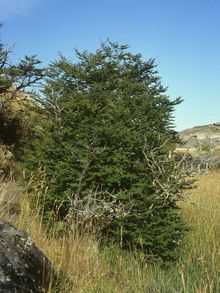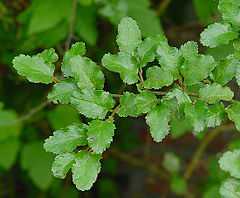Nothofagus antarctica
| Nothofagus antarctica | |
|---|---|
 | |
| N. antarctica in Torres del Paine National Park | |
| Scientific classification | |
| Kingdom: | Plantae |
| (unranked): | Angiosperms |
| (unranked): | Eudicots |
| (unranked): | Rosids |
| Order: | Fagales |
| Family: | Nothofagaceae |
| Genus: | Nothofagus |
| Species: | N. antarctica |
| Binomial name | |
| Nothofagus antarctica (Forster) Oerst. | |

Nothofagus antarctica (Antarctic Beech; in Spanish Ñire or Ñirre), is a deciduous tree or shrub native to southern Chile and Argentina from about 36°S to Tierra del Fuego (56° S), where it grows mainly in the diminishing temperate rainforest. Its occurrence on Hoste Island earns it the distinction of being the southernmost tree on earth.
Description
Nothofagus antarctica typically grows 10–25 m (32–80 ft) tall and has a slender trunk with scaly bark. The leaves are simple and alternate, growing 2-4.5 cm long, and often viscid, with a sweetly scented wax. The leaf color is medium green, turning yellow to orange in the fall. The leaves are broadly ovate to triangular, crinkly, rounded at the tips, irregularly and minutely toothed. The flowers are inconspicuous yellow-green catkins. The fruit is a 6 mm, very fragrant 4-valved capsule containing three small nuts.
Cultivation
N. antarctica has been planted on the North Pacific Coast of the United States[1] and in Great Britain where it thrives. Trees planted in the Faroes, which were imported directly from its southernmost distribution in Tierra del Fuego, have shown good hardiness.[2]
NB: Nothofagus moorei, found in Australia, is also referred to as "Antarctic beech".
References
- ↑ "Nothofagus antarctica in Washington Park Arboretum". Seattle Government. Retrieved 2009-06-27.
- ↑ Højgaard, A., J. Jóhansen, and S. Ødum (eds) 1989. A century of tree planting in the Faroe Islands. Føroya Frodskaparfelag, Torshavn
Further reading
- Donoso, C. 2005. Árboles nativos de Chile. Guía de reconocimiento. Edición 4. Marisa Cuneo Ediciones, Valdivia, Chile. 136p.
- Hoffmann, Adriana. 1998. Flora Silvestre de Chile, Zona Central. Edición 4. Fundación Claudio Gay, Santiago. 254p.
- Rodríguez, R. & Quezada, M. 2003. Fagaceae. En C. Marticorena y R. Rodríguez [eds.], Flora de Chile Vol. 2(2), pp 64–76. Universidad de Concepción, Concepción.
External links
- Photos
- "Nothofagus antartica". Encyclopedia of Chilean Flora. Retrieved 2009-06-27.
- "Nothofagus antarctica". Chilebosque. Retrieved 2009-06-27.
- "Nothofagus antarctica, Description and images". Chileflora. Retrieved 2009-06-27.
- "Nothofagus antarctica at Crarae Gardens, Scotland". PlantenTuin Esveld. Retrieved 2009-06-27.
| Wikimedia Commons has media related to Nothofagus antarctica. |
| ||||||||||